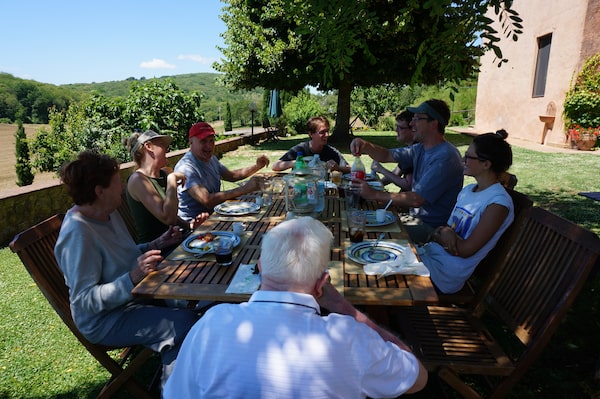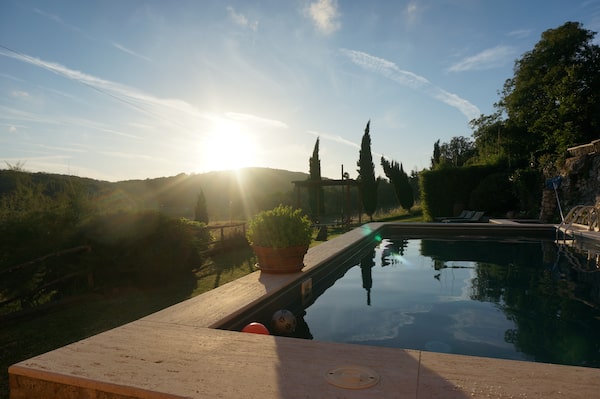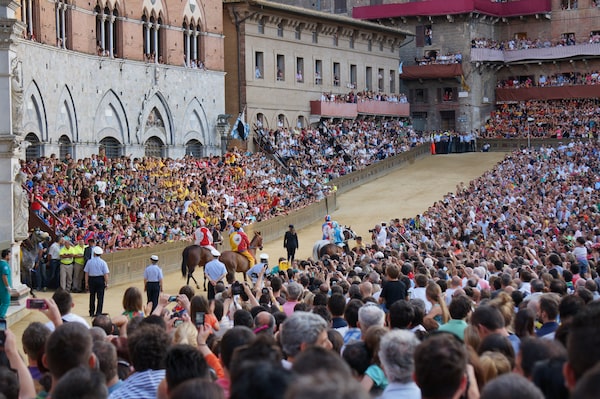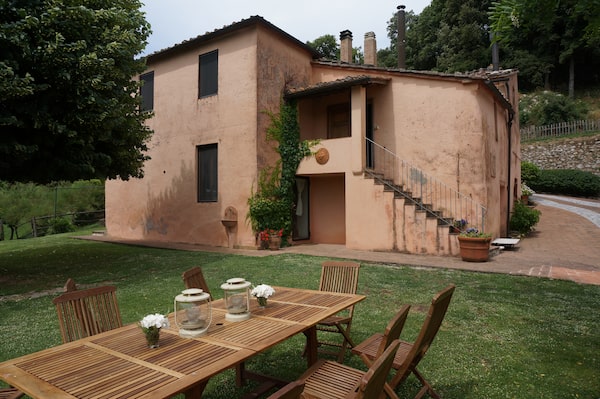
Johanna Schneller and eight family members rented a villa in the Italian region of Tuscany.Courtesy Of Johanna Schneller
Day one does not start out well. Three generations of my family have rented a villa in Tuscany for two weeks. From Boca Raton, Fla., comes my eightysomething mother, Joanne, and her boyfriend, Bob, a full 10 years older. From Los Angeles, my sister, Anne, and her husband, Mark, adventuresome lawyers in their mid-40s. From northern Virginia, my brother’s two sons, Zach and Noah, in their mid-20s. And from Toronto, my husband, Ian, my daughter, Hayley, (also early 20s) and me. We arrive with six tonnes of luggage and a full complement of contradictory hopes, follies and neuroses, all crammed into an enormous white standard-shift Fiat van, “the only nine-person vehicle in Italy,” the rental agent tells us, clearly appalled.
Partly because we can’t check into our villa until 3 p.m., partly because we’re addled by optimism, we decide that driving to the walled town of San Gimignano, with its famous thicket of towers, is a great idea for our first day. You can’t drive into these ancient towns; they’re too fragile. So we park at the foot of the wall and unload the wheelchair we’ve rented for Bob. He’s a proud guy, though; he sets off walking. Mark follows, discreetly pushing the chair.
Every street runs uphill. We round a bend. More uphill. “Why is this city so hilly?” Joanne asks peevishly. Uh-oh. The phrase “the hill towns of Tuscany” is sinking in. One of the great things about my family is that our liabilities become running jokes – an essential component for any group vacation – but it will take us 48 hours to find this day amusing.
So it is with enormous relief that our property rental, Podere le Caggia, in a hamlet called Sovicille, 17 winding kilometres from Siena (which you can see from the top of our hill), turns out to be the exact villa of all our fevered Tuscan fantasies. Three hundred years ago it was a farmhouse for the 1,000-year-old castle that still stands a kilometre down the road. The current owner, Elisabetta, a painter, bought it as a ruin in the 1980s. In the 1990s, she teamed up with two business partners, Jacopo and Fabio, who pulled off a near-perfect renovation, keeping everything characterful about the house, with subtle modernization. When I first see the kitchen, all windows, slabs of tile and butcher-block counters, I kid you not, I cry. (There’s also a rack of local wine for sale, a nice touch.)

The Podere le Caggia property features a pool and hot tub landscaped into the hill.Courtesy Of Johanna Schneller
The main house and cottage, nestled in a field of wheat and poppies, comfortably sleeps 12. There’s a perfect pool, with a perfect hot tub landscaped into the hill above it. (Jacopo and/or Fabio slip by once a day, invisibly, to whisk away garbage and fire up the hot tub with sod bricks.) There’s a generous wooden dining table under a linden tree, so heady with blooms that I swoon every time I pass under it. Fat bees buzz in the branches; every now and then one zips into the pool for a sip.
Elisabetta lives in a renovated barn halfway between our villa and the castle, but all we see of her are a half-dozen of her paintings hung around the house, moody abstracts in greys and blues. A self-portrait of her, naked, hangs in my attic room, a flame where her heart is.
The only caveat is that you can’t leave your shoes outside – wild deer will eat them. At night you can hear them barking, like hoarse dogs.
The house, we soon realize, is the magic formula for three generations on holiday together: Pick a place you never have to leave.
This means that if we all want to do a wine tasting in Brolio, or shop for pecorino wrapped in black oak leaves in Pienza, a UNESCO World Heritage Site, or eat zucchini carpaccio in a stone-cave restaurant recommended by the travel writer Rick Steves (Joanne loves Rick Steves), Joanne and Bob will come with us. We’re pleased to discover that Tuscany is full of strapping young taxi, car and bus drivers who leap out of their vehicles to offer Bob a lift to the top of the town (which saves the day more than once).
But if some of us want to spend a long day in Lucca, visiting Puccini’s house and walking the 2,000-year-old perimeter wall, now a park full of joggers and cyclists; or climb the vicoli (steep, narrow, covered, staircase-like streets) to the top of Montepulciano; or eat pizza slices and truffle spread on a bench in Castellina in Chianti, and then stop on the way home to explore an Etruscan tomb, the Ipogeo di Montecalvario, we can, because we don’t feel guilty leaving Joanne and Bob back in paradise.

The Palio di Siena horse race in Siena’s Piazza del Campo.Courtesy Of Johanna Schneller
It means that the day before the Palio – the crazy, bareback horse race around the shell-shaped Piazza del Campo in Siena, which dates to 1633, in which riders representing 10 of the city’s fiercely loyal wards, or contrade, vie for honour – the rest of us can hang out in the square all afternoon, watching teenagers flirt; we can witness (finally) the pomp and ceremony of the practice run (hours of marching, cannon booms, flag waving and singing, versus seconds of actual racing); and we can stay late into the night, while the city buzzes with sprawling communal dinners. You can hear the roar of them around every corner and every wall, table and sleeping baby is draped in its contrada’s multicoloured scarves and flags.
Joanne and Bob can manage one event a day at most, but this turns out to be an excellent lesson: One thing a day can be plenty. Too often, I’m frantic to get the most bang for my travel buck, which means I race around. Being forced to slow down teaches me that I can have a more vivid, memorable holiday by spending a whole afternoon picking wildflower bouquets for everyone’s bedrooms, or making iced tea from the mint in the garden, or walking down the road to a field of sunflowers and standing in it, than I can by tramping through one more town.
It means that we wring a full day’s entertainment from a visit by the neighbour’s dog, whom we call Roveri (his owner, a journalist, finally comes to collect him; the dog’s name turns out to be Pollack, after the painter); and another full day when Jacopo and Fabio make us a feast: lasagne; chicken with olives; tomatoes, potatoes and cabbage slaw, all from the garden; green salad with chick peas; vegetarian torta in filo; and dark-chocolate cake, 25 euros a person. We dine three times at a restaurant five minutes away, Donato e Donata, where there’s no menu – you just plop down at the communal tables, outdoors under a canopy and eat the three pastas Donata makes, followed by the sausage and/or steak that Donato grills. People bring their dogs; one night we meet Pollack’s father.

An al fresco dining table sits outside the Podere le Caggia.Courtesy Of Johanna Schneller
Late in our stay, we all go to Cortona, a postcard of a town on the border of Umbria, the last city in Charlemagne’s empire, with Etruscan stone walls that are 2,500 years old. From the top, we can see Lake Trasimeno, which legend claims was red with blood after Hannibal defeated the Romans in 217 BC; 15,000 died. We have achieved a rare feat – we’re all at the same level of blissed-out travel harmony, at the same moment – and for once we’re smart enough to appreciate it.
Noah shops for souvenirs. Zach, a foodie, eats his first rabbit. Anne and Mark take a walk. Hayley, Ian and I go to the Diocesan Museum opposite the Duomo, where Hayley, an art-history major, stumbles onto a painting she’d studied, Annunciation by Fra Angelico. In its centre, in a courtyard house set on a pillow of blossoms, a golden-winged angel whispers to Mary; painted words issue from her mouth. The three of us stand in front of it for a long time, while Hayley explains its unusual use of perspective and the expense of its gold leaf. We don’t have to rush off anxiously, because Joanne and Bob are having a gelato at a table in the square.
When we all meet up in the late-afternoon light, Joanne puts into her purse the sparkly plastic frill that came stuck in the gelato and Bob gets into his wheelchair. Mark spins him around and backs him all the way down the hill.